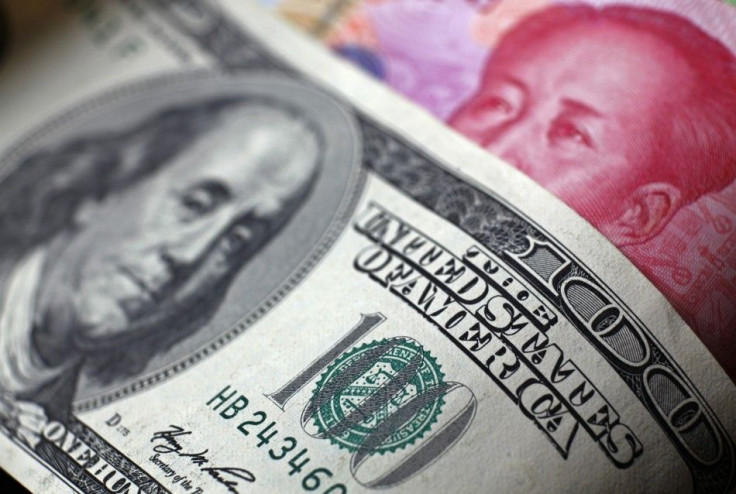China 2Q GDP Preview: Worst Growth Since 2008 Crisis To Hit US Corporate Profits

China will announce its official reading on the country's economic growth for the second quarter on Friday morning in Beijing -- or 10 p.m. Thursday in New York.
And it's not going to be pretty.
A parade of weakening economic reports has led to a universally accepted expectation that the Chinese economy probably expanded 7.6 percent in the second quarter of 2012, down from 8.1 percent in the first quarter, and the slowest since the first three months of 2009 when growth slipped to 6.6 percent.
When the world was brought to its knees following the collapse of Lehman Brothers, China was posting double-digit growth that steered the globe out of recession.
But we might have seen the last chapter of that miraculous growth story.
Economic growth of 7.6 percent would put China just a whisker above its 2012 annual growth target of 7.5 percent, and supports market forecasts that the world's second-largest economy could grow at its slackest annual pace in 13 years this year at 8.2 percent.
Chinese Premier Wen Jiabao warned Sunday of huge downward pressure on the Chinese economy, in the clearest expression yet of concern at the top of the country's leadership about a sharp slowdown.
China's June 7 surprise interest-rate cut, the second in less than a month, suggested that policymakers in China are increasingly rattled by the state of the economy.
The rate cut came far sooner than expected. There was widespread anticipation that the required reserve ratio would be cut again soon, but most were expecting the next benchmark rate cut to be delayed until the end of July or later.
The most likely explanation is that policymakers have had an early glimpse of the June data and have not liked what they have seen, Mark Williams, chief Asia economist at Capital Economics, wrote in a note to clients.
China's June trade data released Tuesday by the General Administration of Customs stoked anxiety about the strength of China's domestic demand as imports rose at only half the pace expected.
China is the world's second biggest oil consumer behind the U.S. and if its economy slows, its energy consumption will drop.
Crude imports into the country last month fell 14 percent from May to a seven-month low. Admittedly, this partly reflects lower global prices, but the growth in the volume of imports also slowed sharply in May.
The imported volume of major commodities also points to an economic slowdown. Imports of iron ore, steel products and copper have all shown notable deceleration in June.
Growth in exports slowed as well. China's exports grew 11.3 percent year-on-year in June, slower than the 15.3 percent growth recorded in May.
Chinese manufacturing in June grew at its slowest pace in seven months.
The country's National Bureau of Statistics and the China Federation of Logistics and Purchasing reported the official purchasing-managers index for June at 50.2, down from 50.4 in May.
Inflation continued to ease. June's consumer price index dropped to 2.2 percent, its lowest level since January 2010 and well below Beijing policymaker's 4 percent annual target.
That leaves sufficient room for Beijing to take more aggressive policy easing actions to support growth.
While a separate report released Thursday showed new loans in June topped forecast -- reaching 919.8 billion yuan ($144.3 billion) and up from 790 billion yuan the previous month -- it is questionable how much stimulus China really needs at this point and, in particular, the degree to which more investment-led growth should be welcomed.
The danger is that the government, in guaranteeing itself a strong second half to the year, raises the chances that widespread overcapacity emerges later, leading to greater economic instability in the future Williams said.
Along with the GDP report, the National Bureau of Statistics is also expected to publish fixed-asset investment, retail and industrial production figures on July 13 in Beijing.
Fixed-asset investment likely have risen 20.1 percent in June, steady from May's pace of growth, but down from around 25 percent seen for most of last year.
Retail sales are forecast to expand 13.5 percent, the weakest pace since February 2011. Meanwhile, growth in factory output is estimated to edge up slightly to 9.8 percent, from May's print of 9.6 percent.
Many U.S.-based companies have cut their earnings estimates, citing a slowdown in China.
Chip-equipment provider Applied Materials, Inc. (Nasdaq: AMAT) lowered its earnings estimates on Tuesday, attributing it partly to China.
Truck engine maker Cummins Inc. (NYSE: CMI), personal computer processors maker Advanced Micro Devices, Inc. (NYSE: AMD), Yum! Brands, Inc. (NYSE: YUM) and McDonald's Corporation (NYSE: MCD) have also voiced the same concern.
Many fear that Apple Inc. (Nasdaq: AAPL), which is due to report its fiscal 2012 third-quarter earnings results on July 24, will also feel the pinch.
Apple will start selling the newest version of the iPad in China, its second-largest market, on July 20 after paying $60 million to settle a dispute over the ownership of the tablet computer's name.
In the second fiscal quarter, Apple generated $7.9 billion of revenues from China. That was more than 20 percent of Apple's total revenue for the quarter and was more than three times the revenues generated a year earlier.
Shares of Apple Inc. (Nasdaq: AAPL) fell 1.44 percent, to $595.72 apiece, in Thursday's midday trading.
© Copyright IBTimes 2025. All rights reserved.






















